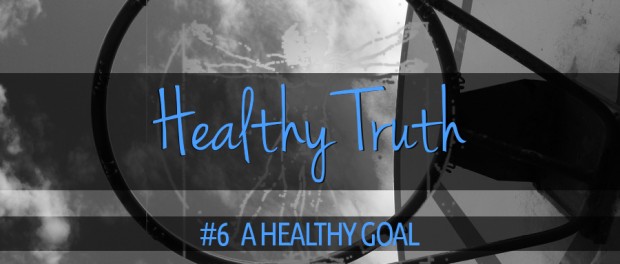Healthy Truth #6 – A Healthy Goal

Truth #6 – Health is my most healthy goal.
In a letter to his pupil, the apostle Paul offered some insight into the nature of health (1 Timothy 4:8, NIV):
For physical training is of some value, but godliness has value for all things, holding promise for both the present life and the life to come.
Health is bigger than having a fit body; it is a state that carries spiritual, emotional, sexual, mental, and relational facets as well. A cut diamond polished on only one side will fail to shine light like one that has been cut and polished true. Likewise, when we embark on this fitness journey, we should strive for a goal of integral health rather than a certain weight, dress size, or waistline (see Truth #7).
Even in a purely physical realm, the shortsightedness of such arbitrary goals is evident if we’re rational. Malnutrition can trim your waistline through anorexia nervosa, methamphetamines can drop you down a size or two easily enough, and there’s no faster way to lose weight than voluntary limb amputation. Intellectually, we know such ideas are invalid strategies because they compromise overall health in an evident way.
But I’m convinced this is what most dieters, weight lifters, and other people who are now haunting the gym for the first time in ten months are doing. As Proverbs 14:12 says, “There is a way that seems right to a man, but in the end it leads to death.”
People hear carbs are bad (false), fat is bad (false), cholesterol is bad (false), meat is bad (false), beans are bad (false), and on and on and on until there’s nothing safe left to eat in the world except for some specific list they can learn for only three easy payments of $29.95.
Each claim is supported by intimidating and convincing statistics, though the studies behind the statistics rarely if ever support the broad conclusions made against the data.
People read that you can sculpt your muscles (false) or tone up specific areas (false), that stretching is bad for strength (false), that it’s healthier to stand at your desk than sit (false), and that this video/workout/magazine/pill/book will make you look like them (false, see Truth #1).
Each claim is supported by intimidating and convincing statistics, though the studies behind the data rarely if ever support the broad conclusions purported using the statistics.
Here’s some straightforward data for you: In the Women’s Health Initiative, a huge randomized sample of twenty thousand women were checked for a considerable amount of time — just shy of eight years — while strictly maintaining a diet of moderation.
In this study, the largest and longest-running clinical trial of its kind, the end result was clear: weight hadn’t changed at all over all that time, though many waistlines had (see Truth #10). The women were healthier, but they’d have been sorely disappointed if their goals had been focused on weight loss.
Here’s another study, this one performed by the Institute for Exercise and Environmental Medicine at the Texas Health Presbyterian Hospital of Dallas. They collected a group of elite athletes who regularly competed in multiple marathons, distance cycling events, or even Ironman competitions, and studied the physiologies of these highly competitive people. A researcher, Dr. Santiago Lorenzo, described their cardiovascular condition as “very strong and very healthy” and commended their “outstanding endurance”. He said “they have developed an ability to generate a higher airflow and deliver ample oxygen to their blood and muscles.”
So what’s so special about some athletes having excellent conditioning and health? Why is that such a shocker?
Because each and every one of them had a body fat percentage of more than thirty percent, placing them well into the obese categories according to traditional indicators such as the BMI (a practically useless “measurement”).
The truth is there’s a range of about ten to twenty pounds that our bodies will work hard (even against us) to maintain long-term despite any short-term gains we happen to make. The only sustainable option is to seek health itself, spirit, soul and body. When we strive for other goals, we’re likely to pursue them in unhealthy ways.
As a personal trainer, I hesitate to take on a client that has a goal that supersedes health (be it weight loss, strength gain, or anything else that might not be a bad thing if it wasn’t so emphatically more important than overall health). I’d much rather a client seek health as their primary goal, and contentedly accept whatever gains or losses in weight, waistline, or bench-press may come as a byproduct of that now healthy lifestyle (see Truth #5).
Across the board, health is my most healthy goal.
Originally posted 2016-02-05 08:00:50.


Leave a Reply